Abstract
Pakistan has seen a violent transition from a nation that advocated inclusivity for all sects of Islam to much pronounced sectarian fissures. The sectarian divide between the Sunnis and Shias is intractable. This paper seeks to trace the origin of the sectarian differences and the resulting sectarian violence in Pakistan and dwell upon the co-relation of such sectarian violence with political evolution. The paper also looks at how terror groups in western Pakistan have used the implementation of Sharia laws as a tool to carry out insurgency rather than jihad. The paper focuses on the changing trends of sectarian strife in western Pakistan, its impact on insurgent groups like TTP and how the population is being affected by these changes.
Introduction
Pakistan was created as a separate homeland for all kinds of Muslims by Mohammad Ali Jinnah, embracing all sects of Islam and offering places of prominence to the intelligentsia of Islamic minorities. Islam in Pakistan has seen the transition from an all-inclusive credentials in 1947 to a fractured mandate in 2023, wherein fissures have emerged between Shia and Sunni, Barelvi and Deobandi, Ahmadis and Sunni. Before the partition, there was no identity crisis or insecurity among various sects. The cracks emerged in the idea of Pakistan. There were differences between Barelvis and Deobandis, as they had contrasting views on the idea of a Muslim nation and not an Islamic nation; Deobandis were more in favour of autonomy within the existing setup, whereas Barelvis wanted a separate homeland for Muslims, as they thought co-existence is impossible.
The Sunni- Shia Divide in the 1950s
Barelvis had a better inter-community presence due to Sufism and many practices which found their roots in ancient Hindu traditions. At the time of partition, most Barelvis did not relocate and continued to live in the original places, probably due to their local murshids. Deobandis, majorly from UP heartland, migrated from India to Pakistan. The Muslim exodus from Punjab settled in Pakistan Punjab, predominantly Barelvi, as most of the Deobandis from Uttar Pradesh ended up as Mohajirs. A dream of a promised land as conceived by Mohammad Ali Jinnah, where Muslims from all sects of Islam and walks of life could exist and live peacefully and happily, was short-lived. The non-acceptance of Bengali Muslims in governance, coupled with the ambitions of Punjabi Muslims in everything, resulted in cracks in the community; with Jinnah and Liaquat Ali Khan's deaths in quick succession, there was no one with the vision to handle Pakistan properly. The cracks emerged with the Lahore riots against Ahmadis of 1952, and later, in the constitution of 1974, Ahmadis were declared non-Muslims. Sunnis got the divine right to destroy Ahmadis establishments, loot properties, and accuse them falsely. As time went by, Sunni and Shia differences (which have existed since time immemorial) also started to turn violent, including attacks on Muharram processions. Contiguous to this was the Punjabi-Bengali divide, which finally gave birth to Bangladesh. Deobandis, about 20% of the population, had the hunger to be politically relevant. Moreover, Maulana Maudidi’s concept of Islamic governance (Jamaat-i-Islami) further encouraged religious Hukumraans (religious teachers) to dabble with politics and governance. About 50% of Barelvis could not be as effective as Deobandis due to their internal divisions amongst Gaddinashins, Peers and Murshids despite their domination in the two largest states, Punjab and Sindh. Zulfikar Ali Bhutto had cashed on the Sindhi identity. However, he was Shia by origin—his hanging by General Zia ul Haq after the coup did not go kindly with the public then. General Zia was a devout Deobandi Muslim who Islamised the Pakistan Army and governance, killing two birds with one stone, i.e. overcoming sentiments of killing Zulfikar Ali Bhutto and getting a better grip on government despite being a migrant from India.
The Afghan Jihad and Zia-ul-Haq
The Afghan jihad had given an advantage to Deobandis and Ahle Hadis, which were majorly imported from the Middle East, with the Arab Mujahideen and Saudis being custodians of Sunni /Wahabi Islam more than willing to fund it. However, Pashtuns were only willing to dabble in politics and hold on to Khyber Pakhtunkhwa (KPK) and North Balochistan.
General Zia's propagation of Tablighi Jamaat further consolidated the Deobandi hold on the environment, especially in Saraiki Punjab, as the social fabric was feudalistic. Barelvis, though financially sound, wanted to avoid getting involved as they still had a sizable population, and Peers and Murshids had a say in local governance.
Deobandis and Rise of Tehreek-e- Labbaik
It was finally Pervez Musharraf, another Mohajir, who founded the Sufi council to get Barelvis together. Subsequently, the creation of Tehrik e Laibaak Pakistan (TLP) got Barelvis further close, making them a sect of relevance. While Deobandis were already part of governance, TLP, in the elections of 2018, came out as the fifth largest party in Pakistan. The emergence of TLP further made Barelvis realise their relevance, positioning, and power. TLP's performance in Sindh further shocked Deobandis as TLP had performed better outside their comfort zone of Punjab.
As the years passed, a subconscious tussle/struggle emerged between Sunnis and Shias, Deobandis and Barelvis, and Deobandis and Ahmadis all over Pakistan. Ahl-e-Hadees slowly slipped into the space created by Deobandis, following the same ideology of intolerance and hatred.
Ahmadis, over the years, became extinct, and systematically Shias are being eliminated. Barelvis are slowly trying to increase their presence. However, Deobandis dominate West Pakistan courtesy of Darul-Uloom Haqqania, Peshawar and Binori Masjid, Karachi, whose alma maters rule the roost there. Alma maters in various permutations and combinations exist in TTP, Al Qaeda and a minimal number in ISKP. To add to the chaos and due to international pressure Lashkar e Taiba (LET) and Jaish e Mohammad (JEM) also had to move a sizable chunk of men and resources from Punjab to Balochistan. While Deobandis focus on terrorism, Barelvis are more into Sharia Law and blasphemy. Nevertheless, the veneration of Sufis by Deobandis has been the primary cause of conflict between the two.
The TLP ideology has found its fans in western Pakistan for righteous living, based on the Quran, resulting in the expansion of Barelvi thought, which has not gone down well with the Deobandi and Wahabi groups. There are a sizable number of Sufi shrines in this area, as it was one of the primary routes to travel from Iran to India.
Islamic state’s arrival in the Indian subcontinent to establish the Caliphate, coupled with Deobandi and Ahle Hadi's quest for dominance, is forcing them to dissuade/discourage and contain the expansion of Barelvi/Tehreek e Taliban (TTP), Jamaat ul Ahrar (JUA), and Haqqani Network (HN) to maintain attack zones in Mastung and near Hangu. ISKP has had attack zones in Mastung since at least 2021 and has conducted six out of its 11 attacks in 2023 in Mastung. ISKP has also led numerous attacks near Hangu and Kohat since 2021, and it recruited leadership and fighters from Hangu between 2015 and 2018, suggesting ISKP still has support in this area.
Barelvi Islam in the east of Pakistan was well entrenched, i.e. in Punjab and Sindh, with centuries-old traditions and practices of Sufism, Urs, Peers and Murshids. Data Ganj at Lahore to Shewan Sharif in Sindh, Barelvis enjoy considerable clout. Moreover, with the TLP spreading its reach, it is further consolidating its position. However, this is different in western Pakistan where the prominent sect Deobandi/Ahle Hadees, which is far more radical than Barelvi, may go in for the implementation of Sharia laws.
Sectarian Influence on Terror Western Pakistan
There is a systematic disappearance of minorities like Shias and Barelvis from upper Balochistan either by killing or kidnapping Barelvis leaders and maulanas. Many unregistered madrassas are growing, keeping the aim of increased religious education in mind and reducing scientific temper in the region. Islamic teaching is prioritised over scientific temper as per the direction of Ulemas, and local teachers are compelled to teach Islam and not sciences like the rest of the world. The concept of Naql is dominating Aql for Deobandi Maulanas to have an iron grip over the people. Barelvis do have support in terms of TLP, but that is embroiled in politics rather than supporting basic tenets of Barelvi Islam. Most of the groups came drumming up jihad and Ghazwa e Hind and for imposing Sharia across Pakistan, but somehow have not moved much out of their comfort zone.
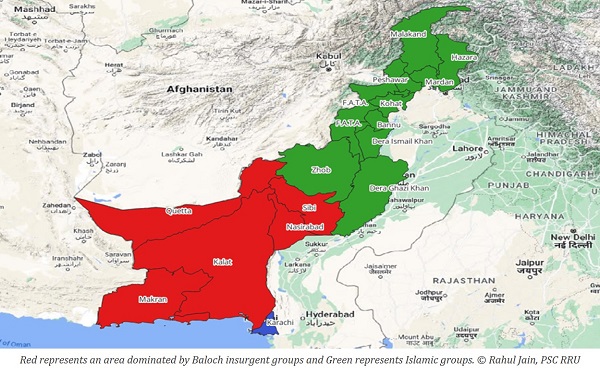
The present state of groups in West Pakistan is TTP, ISKP, BLA, and BLF, which are all trying to dominate their respective areas, but at the end of the day, it is sectarian strife under the garb of jihad with demography to back it up. The TTP wants to restrict themselves to KPK ruling and implementing Sharia whereas Balochs are looking for sovereignty for Balochistan only. So, ideally, no group is looking at transnational jihad. All groups are limited to their respective areas. There would be certain outliers like splinter groups JUA who have hit targets outside the general beat of the group, or the target was too lucrative in terms of return on investment (ROI), like the masjid at Peshawar. The demographic fault lines have a background in this whole concept of fracturing Pakistan falling under the control of various sectarian groups. Pakistan has multiple ethnicities and sectarian groups very loosely joined by glue called Islam but this experiment has not been successful.
The strike profile and mapping clearly show that the groups have comfort zone areas where they prefer to operate. The area with a demographic profile of the same ethnicity gives them space to operate and have hideouts to stay in, taking it closer to the definition of insurgency and not terrorism. However, transnational or trans-operatives would still fall under the definition of terrorists.
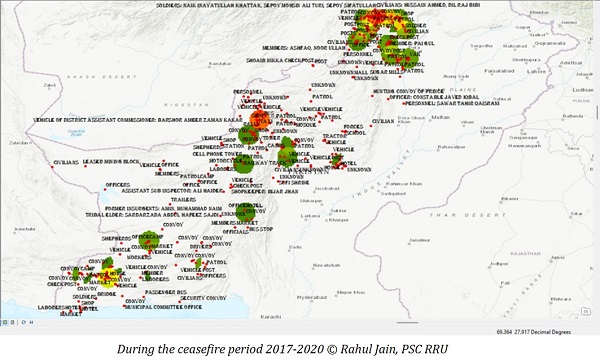
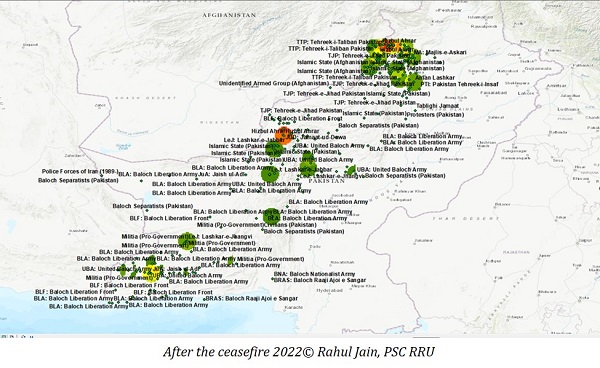
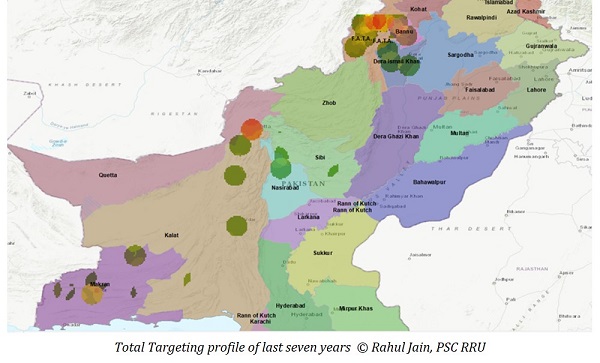
While all these terror groups profess jihad they are no more than locally dominant sectarian groups with neither having a genuine plan to govern except an outlier like the Taliban in Afghanistan. As per tenets of Islam, jihad has to exist till universal dominance of Islam is achieved all over the world. However, the idea of jihad propagated in this part of the world is quite different from the Middle East. Jihad is waged against believers of Islam who have not shown any aggression toward these groups. No Emir-e-Momins have declared to call for such an offensive jihad. Zakat also finds its way into the paradigm of jihad, wherein 1/6th to 1/8th part of Zakat should only be used for jihad. The very fact of a concept of Caliphate needs a jihad, which is classically not happening.
It is by and far the only area in the world where jihad is waged against believers. The partial and quack Maulanas are propagating their concepts of Islam, not letting the faithful Islam be understood by people, destroying Western education by various means, and pushing the country back to the Stone Age. Some incidents have taken place which reflects that Madrassa education is encouraged, and conventional sciences have been discouraged by maulanas to the extent that teachers swear against the Darwin theory under compulsion. The off-late blasts at Matsung and Hangu without any reverence to the 12th day of Rabbi e Awwal show the desperation and lack of concern for religion in these sectarian wars. There appears to be no setback to the Barelvis sect, which continues to expand in KPK and Balochistan.
Present State
Four significant groups divide the Pakistani public.
- Urban Elite: Western-educated and settled abroad, Pakistan is an alternative business option for them. Some of them indulge in politics, too. Many of them are part of governance in their respective adopted countries.
- Uber Rich Feudals: They are generally Western educated/convent’s products, who though educated, prefer the feudal system to continue. They are typically aligned with one political party or another and try to stay loyal.
- Middle-class: The middle class can be equated with the lower middle class of the rest of the world. The daily effort is to make ends meet and provide essential nutrition and education to the family. They are the primary target of governance in terms of taxes, levy, subsidies and quotas.
- Poor: Less said the better, scavengers by profession, live off the land, are ideal target for terror recruitment by various groups.
Conclusion
Pakistan was created based on its unique Islamic identity. The sectarian differences were not expected to create major problems and Muslims in India sought the partition enthusiastically. However, sectarian cracks began to appear in the 1950s and later became more pronounced. Most of the political masters exploited these fissures to their advantage. With 85% Sunnis, Shias were almost irrelevant on the sectarian chessboard; a lot of Shia leaders compromised on their identity and stood in line with the Sunni sects.
With every major event, these cracks began to widen, starting from the late 1950s to Afghan Jihad (Deobandi and Ahle Hadis), Al Qaeda (Hanafi plus Ahle Hadis) Taliban ( Deobandi plus Ahle Hadis), Zia’s propagation of Deobandi Sect, Musharraf s support to Barelvies, the birth of TLP and Ahle Hadis riding piggyback on maulvis. However, it did not make a significant dent in the religious fabric till terror groups started to use sectarian identity as part of their ideology. Sectarian identity coupled with the Gazwa-e-Hind ideology has brought the wall crushing down. Today, Pakistan is becoming a sectarian-centric nation with terror groups sprouting up like mushrooms (every third day, a new group is born). This tendency, if not controlled, would make Pakistan ungovernable and more likely lead to it becoming a nuclear-powered rogue state.
(The paper is the author’s individual scholastic articulation. The author certifies that the article/paper is original in content, unpublished and it has not been submitted for publication/web upload elsewhere, and that the facts and figures quoted are duly referenced, as needed, and are believed to be correct). (The paper does not necessarily represent the organisational stance... More >>
Image Source: https://borgenproject.org/wp-content/uploads/shia.jpg

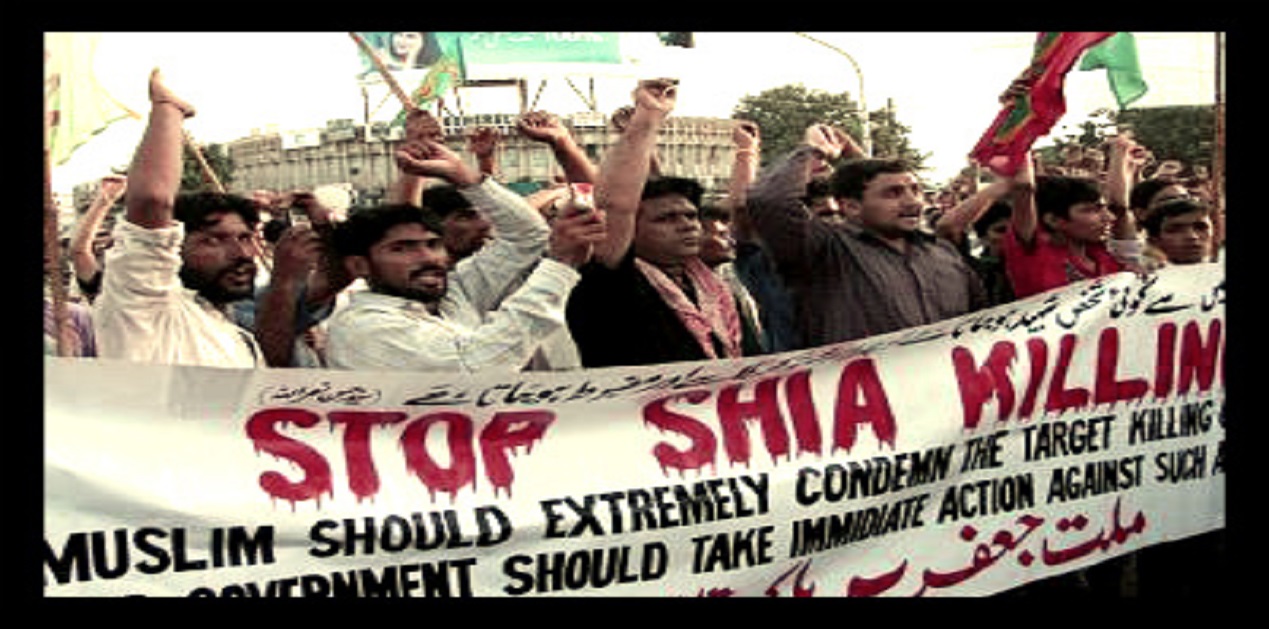








Post new comment